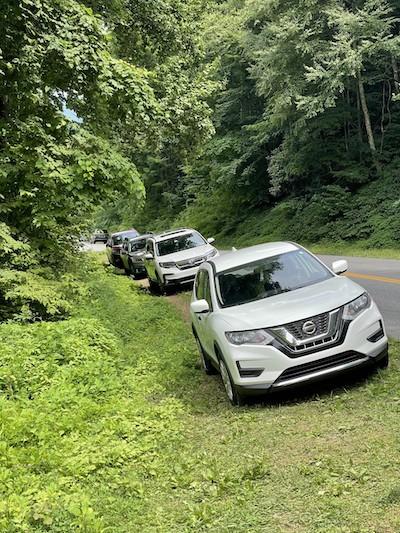
Great Smoky Mountains National Park crews will install barriers to prevent this kind of parking next year/NPS file
In a move to halt illegal roadside parking that greatly impacts the park, Great Smoky Mountains National Park crews will be installing barriers -- boulders, fencing, and wooden bollards -- to protect the road shoulders.
The work will require single-lane road closures at several locations in the park next week so the barriers can be installed. Over the last decade, extremely high use at several park destinations has resulted in unsafe conditions for motorists and pedestrians, increased roadway congestion, and damaged roadsides, park staff said.
“It’s critical that we protect iconic park destinations from the unintended consequences associated with too many people trying to squeeze into the same places at the same time on the same days,” said Superintendent Cassius Cash. “Through this action, we’re helping ensure that people have the opportunity to safely visit in a manner that respects the country’s most visited national park.”
Motorists should expect single-lane, weekday road closures through March at any of the following locations: Newfound Gap Road near the Gatlinburg, Alum Cave and Chimney Tops trailheads; Little River Road near Laurel Falls trailhead; Cherokee Orchard Road; and Big Creek and Deep Creek picnic areas. Roadside protection measures such as boulders, split-rail fencing, and wooden bollards will be installed along these roadways as well as sections of Clingmans Dome Road and Roaring Fork Motor Nature Trail.
Visitors should plan ahead and come prepared with alternative destinations in case they do not find parking available at desired sites. By carefully choosing the time of day, time of year, and day of the week, visitors can help improve their chances of obtaining a safe parking space within designated, durable parking areas even at iconic destinations.
If safe parking is not available at the destination of choice, visitors still have many options for exploration. The park offers more than 800 miles of trails and more than 380 miles of scenic roadways. Staff are available to assist in trip planning, seven days a week, at Sugarlands Visitor Center, Oconaluftee Visitor Center, and the Backcountry Office.



Comments
The Smokies needs to have a shuttle system to reduce the reliance on single car travel. There could be shuttles from the Visitor Center inside the park to high traffic areas. There should also be shuttles originating from Gatlinburg either to the Visitor Center or direct to popular trailheads, similar to the buses that run from Estes Park into Rocky Mountain National Park.
With that, there needs to be strict enforcement of no parking areas. Boot vehicles that are on the roadsid. Just leaving a parking violation sticker just gets ignored.
The Gatlinburg and Pigeon Forge Chamber of commerce shut down a shuttle proposal for Cades Cove in the 90s. Heaven forbid rednecks would be prohibited from driving one tenth of a mile per hour and stopping at every deer sighting. It would have emptied the go kart tracks and buffets. Your notion would empty the casino in Cherokee. Follow the money. It's always about money with the NPS.
Visitors should plan ahead and come prepared with alternative destinations in case they do not find parking available at desired sites. By carefully choosing the time of day, time of year, and day of the week, visitors can help improve their chances of obtaining a safe parking space within designated, durable parking areas even at iconic destinations.
This just won't work. People that come to the park who are not frequent visitors don't know these things. They will be unable to park so they will go on down the toad. At next attraction, they will be unable to park. They will leave, probably to never return due to lack of parking. Paid parking with shuttle service is impractical due to size of park and may disuade people who come because things are free and affordable, especially for large families. The highest attendance of any National Park is about to drop. Think it out Cassius from MSU(U of M). I love the park but parking availability is necessary for the day visitors which I believe are the mainstay of this great wonderland of nature.
Less visitors wouldn't be a bad thing. Definitely need to have parking restrictions people park where ever they want. Very rude and unsafe. Hopefully the admission fees can pay to have people towed that don't obey the proper parking
GREAT Smokies could think about timed entry into paek during busy periods. I t does help spread out use without having to inrease parking.
Tow them, then the towing company and the county gets a kickback
Sounds like a lot of clutter installed when all you needs is a greedy but authorized towing company.